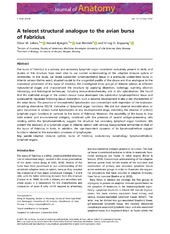A teleost structural analogue to the avian bursa of Fabricius
Peer reviewed, Journal article
Published version

Åpne
Permanent lenke
http://hdl.handle.net/1956/22021Utgivelsesdato
2019-12-26Metadata
Vis full innførselSamlinger
Originalversjon
https://doi.org/10.1111/joa.13147Sammendrag
The bursa of Fabricius is a primary and secondary lymphoid organ considered exclusively present in birds, and studies of this structure have been vital to our current understanding of the adaptive immune system of vertebrates. In this study, we reveal substantial lymphoepithelial tissue in a previously undescribed bursa in Atlantic salmon (Salmo salar), situated caudal to the urogenital papilla of the cloaca and thus analogous to the anatomical placement of the bursa of Fabricius. We investigated three groups of Atlantic salmon at different maturational stages and characterized the structure by applying dissection, radiology, scanning electron microscopy and histological techniques, including immunohistochemistry and in situ hybridization. We found that the epithelial anlage of the salmon cloacal bursa developed into substantial lymphoepithelial tissue and subsequently regressed following sexual maturation. Such a dynamic development is also a key characteristic of the avian bursa. The presence of intraepithelial lymphocytes was concomitant with expression of the leukocyte‐attracting chemokine CCL19, indicative of lymphoid organ functions. We did not observe recombination or gene conversion in salmon bursal lymphocytes at any developmental stage, indicating the absence of primary lymphoid organ functions in contrast to the bursa of Fabricius. However, the possibility of the bursa to trap both enteric and environmental antigens, combined with the presence of several antigen‐presenting cells residing within the lymphoepithelium, suggest the structure has secondary lymphoid organ functions. We present the discovery of a lymphoid organ in Atlantic salmon with striking topographical similarities to that of the bursa of Fabricius in birds. In addition, the age‐dependent dynamics of its lymphoepithelium suggest functions related to the maturation processes of lymphocytes.
